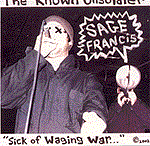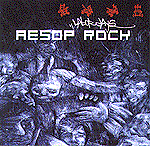
The next generation of hip-hop is here. A street art born in parks and block parties has now invaded cornfields and online websites. Growing up in New Jersey, I idolized Big Daddy Kane, Guru from Gang Starr, and Q-Tip of A Tribe Called Quest. My heroes were rough necks like Kool G. Rap, conscious brothers like Public Enemy and KRS-ONE. Hip-hop was so varied, with artists who were just about fun and rockin' a crowd (Fu Schnikens, Leaders of the New School) as well as emcees who could just rip anyone in their path (Rakim). Hip-hop’s success has led to a fragmenting of the culture into varied levels. The biggest split is Underground vs. Mainstream. The independent scene born out of the commercial success of rap music has created a comfortable space for many artists who maybe ten years ago couldn’t exist. Further, it has been the catalyst to bring hip-hop to regions, demographics and parts of our society that never knew anything about a ghetto music that was being celebrated in the South Bronx. The thing about the independent hip-hop scene is that it has fractured hip-hop into many tiny fragments. These fragments have aspects of the old skool ways and ideals. Others, however, have many of the B-Boy aesthetics, but at their core is something different. Maybe something new. It’s interesting when I go online to a website and the debate is about whether or not EPMD has made a credible contribution to hip-hop or who is eternally the better emcee - Rakim or Sage Francis. Young people who have no ties to black music and inner city life have embraced ghetto music and put their own stamp on it. Artists have expanded the role of emcee, making them accountable now not so much for rocking a crowd as raising consciousness. Hip-hop groups get props for being the most abstract, the most avant-garde as opposed to being the “realest” or the “hardest.” Hip-hop hasn’t so much gone cerebral (it was always intelligent) as it has suburban or rural. This is a good thing, though - acceptance. Hip-hop has finally broken through and is recognized for the art form that it is. It can no longer be dismissed as a fad. Some say that hip-hop had been accepted once it appeared in ads and on television. Anything that has money-making potential can be in ads or on the air. Some people look at the tremendous amounts of money or the witch hunt that went on to censor hip-hop. Again, subcultures have risen and fallen through commercial success and controversy only to disappear or morph into something else (the transformation from disco to house comes to mind). The testament to the expansion of hip-hop is live shows in Michigan and Iowa. Not “concerts,” but full-on small scenes with their own producers, labels, and distribution. The proof that hip-hop is “music” and universal are Anticon. Anticon is an Oakland-based label known for their stable of talent whose more than left of center delivery, antics and attitude towards traditional hip-hop ideas and values have earned them respect and hate all the same. Hip Hop is thriving as much through downloadable mp3 sites were young artists can push their product and online stores (in which kids from Nebraska can order music once only acquired from a major city) as it has through underground and renegade street promotion. The Internet to some degree has given the independent scene a resource akin to radio. Moreover, that same kid from Nebraska is probably one of the local sensations. 
It’s amazing how the style and content of hip-hop has changed. Aesop Rock, a NYC emcee that has three full lengths to his name unsigned (all independently released through him) released a new album under his current label, Def Jux. Labor Days is basically a concept album. Aesop chronicles his own struggles being an artist in a society and environment totally against him. While the idea is classic (keeping it real, chronicle your struggle, telling a tale), the vehicle he uses isn’t. Listening to Aesop is an exercise in word puzzles, much like EL-P or Mike Ladd. Straight away metaphors and word play do not fly here. By the same token you have Apathy and Celph Titled of the DemiGodz clique augmenting the idea of a B-Boy into a crazy augmented version of itself...on steroids. Dose One of Anticon is the extreme ends of this new hip-hop. I picked up his album Circle and was immediately turned off. He wasn’t so much emceeing as he was speaking in sort of a rhyming prose with a high-pitched voice - spoken word. Yet he is a part of a crew that is highly regarded in the independent/underground scene. I went online to find more about him. I found that while what I heard is his basic style, he could rhyme. Because there are more people that rhyme, maybe this is the result: developing new styles to stand out, not bite. Who knows? Listening to any of these artists will not make you think of Buckshot, Biz Markie or Slick Rick. It might be unfair at this stage to even contemplate the current staple of hip-hop icons. Much of what we know as independent only existed five years ago (1996, discussed in these pages before, the Rawkus Era). Still, as the Native Tongues begot a Mos Def or a Black Moon begot a Smif and Wessun, hip-hop doesn’t appear to be carrying on much of the tradition, merely the symbolism. In the 21st Century, hip-hop has finally touched and reached the masses. It will be interesting to see what will occur in the next generation. {mikal lee (hired gun)} |